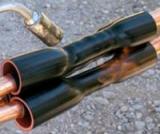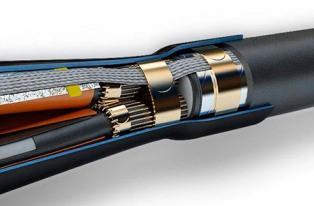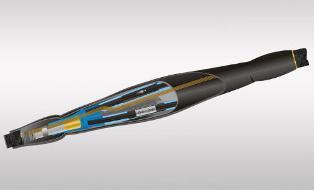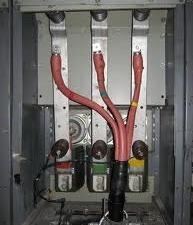Cable seals and their installation
 In the modern electrical market, there is a fairly large selection of cable joints. All cable joints, depending on the purpose (type of fastening), can be divided into connecting, terminal and branching. The use of cable connectors is obvious — to connect cables, and with the help of cable connectors, the cable is delivered to various electrical devices and devices.
In the modern electrical market, there is a fairly large selection of cable joints. All cable joints, depending on the purpose (type of fastening), can be divided into connecting, terminal and branching. The use of cable connectors is obvious — to connect cables, and with the help of cable connectors, the cable is delivered to various electrical devices and devices.
Cable seals are used to create various electrical networks, as well as to connect certain equipment to these networks. Such cable fasteners are a set of materials and parts that are used to connect, branch or terminate electrical wires. In addition, with the help of cable sleeves, not only high-quality docking of power cables is ensured, but also reliable sealing and additional insulation of the docking connector.
The integrity of any connection is affected by electrical parameters such as frequency, insulation coating, voltage and power cable design.
It should be noted that the classification of cable glands is quite complex.However, when choosing connectors, you should pay attention to the following parameters:
• Construction — material and construction characteristics;
• Purpose, influenced by the type of relationship;
• Conditions of use — internal or external laying;
• The value of the nominal voltage;
• Sizes — small or normal;
• Shape- V-, T- and X-shaped;
• Section diameter and number of cores.
By design, modern cable glands can be made of various materials. They can be lead, epoxy, cast iron, heat shrink, plastic, filler, stretch and cold shrink sleeves. Also, the connectors can differ in the way of installation: external and internal.

Heat shrinkable cable glands
Currently, these connectors are the most popular among other types of cable fasteners. They gained their fame thanks to their reliability, harmlessness and simple installation. A heat-shrink cable sleeve of the same size, due to the ability to shrink during heating, can be used for several conductors that have a cross-sectional diameter close to each other.
When this heat-shrinkable type of electrical fittings appeared, for the manufacture of which a high-tech polymer was used, which provides the product with such operational properties as safety, durability, reliability and elasticity, cable seals made of different material became obsolete and were gradually removed from production.

Cable gland
During the installation of cable lines, a cable connection is used. Its main purpose is reliable connection, sealing and protection from various damages in the joints of single-core and multi-core power cables.
As for the insulation coating, cable joints are available for cables with paper or plastic insulation. There is another option for connecting fittings, which is called a transition sleeve. The adapter sleeve provides secure cable connection, both with paper insulation and plastic.
To carry out the laying of power lines in difficult conditions, for example, on steep or vertical routes, two more variants of cable connectors are used — connecting the cable and stop transition. In addition to the function of connecting cables, these types of connection fittings are also able to prevent the cable mass from draining.
Cable connection branch
This is a type that belongs to specialized fittings. The cable branch is exclusively used to connect the branch cable to the power line.
Cable end sleeve
With the help of a cable terminal, cables are connected to various electrical devices and devices.
Installation of cable seals
The main requirement for a cable sleeve is the reliability of operation. Therefore, each connection must have the following properties: tightness, moisture resistance, mechanical strength, electrical strength, resistance to environmental influences. Most of all these requirements are met by heat-shrink sleeves and cold-shrink sleeves, which can be used for cables with different insulation.
Before the installation of the cable sleeve, the end of the cable is cut, which consists in sequential removal of all layers of the outer protective sheath up to the phase insulation of the core.The size of the channel is affected by the voltage, brand and cross-section of the wire, which can be found in instructions and reference books.
• Installation of heat-shrinkable sleeves
The terminal ground wire and the ground circuit continuity wire are installed in the cable joints using the solderless welding system supplied with the product. With the help of sealing tape, the contact connection of the ground wire with the steel sheath is closed. The sealing tape is able to provide corrosion protection to this joint.
The execution of the grounding wires of the connectors is done with a copper flexible cable. The cross-section of the grounding wires must not be less than:
• 16 mm, if the cross-section of the wires is no more than 120 mm;
• 25 mm if the cross-section of the wires is not more than 240 mm.
When installing heat-shrinkable sleeves, there is no need to carry out such environmentally harmful operations as soldering or filling with bitumen. No environmentally hazardous gases are released during the contraction period.
• Installation of cold shrink sleeves
Installation of cable glands of this type does not require heating, which practically cuts installation time in half compared to installation of a heat-shrink cable gland.
The cold shrink sleeve contains EPDM rubber that is pre-stretched over a helix that is removed during installation. During the removal of the spiral cord for the free ends, specially left, a slight shrinkage of the sleeve takes place, which ensures the sealing of the cable.
Additional protection against mechanical stress is provided by the thick walls of the coupling. In addition, the EPDM rubber used is resistant to acids, moisture, UV rays and bases.
Cold-shrink sleeves and heat-shrink sleeves are able to maintain the flexibility of the cable, they also do not collapse under cyclic temperature loads and soil displacement with seasonal changes.
The stopping characteristics of these cable glands make it possible to increase the standard level difference of the cable route for cables with impregnated paper insulation.

